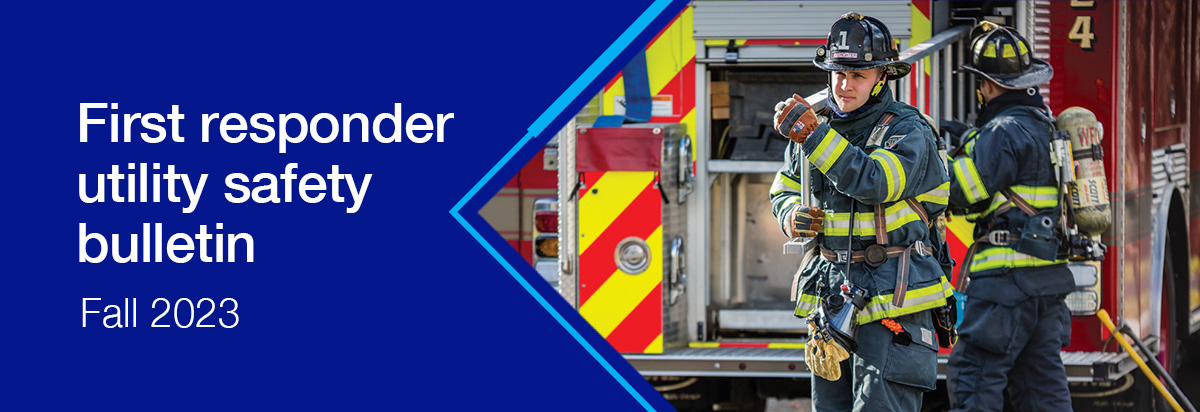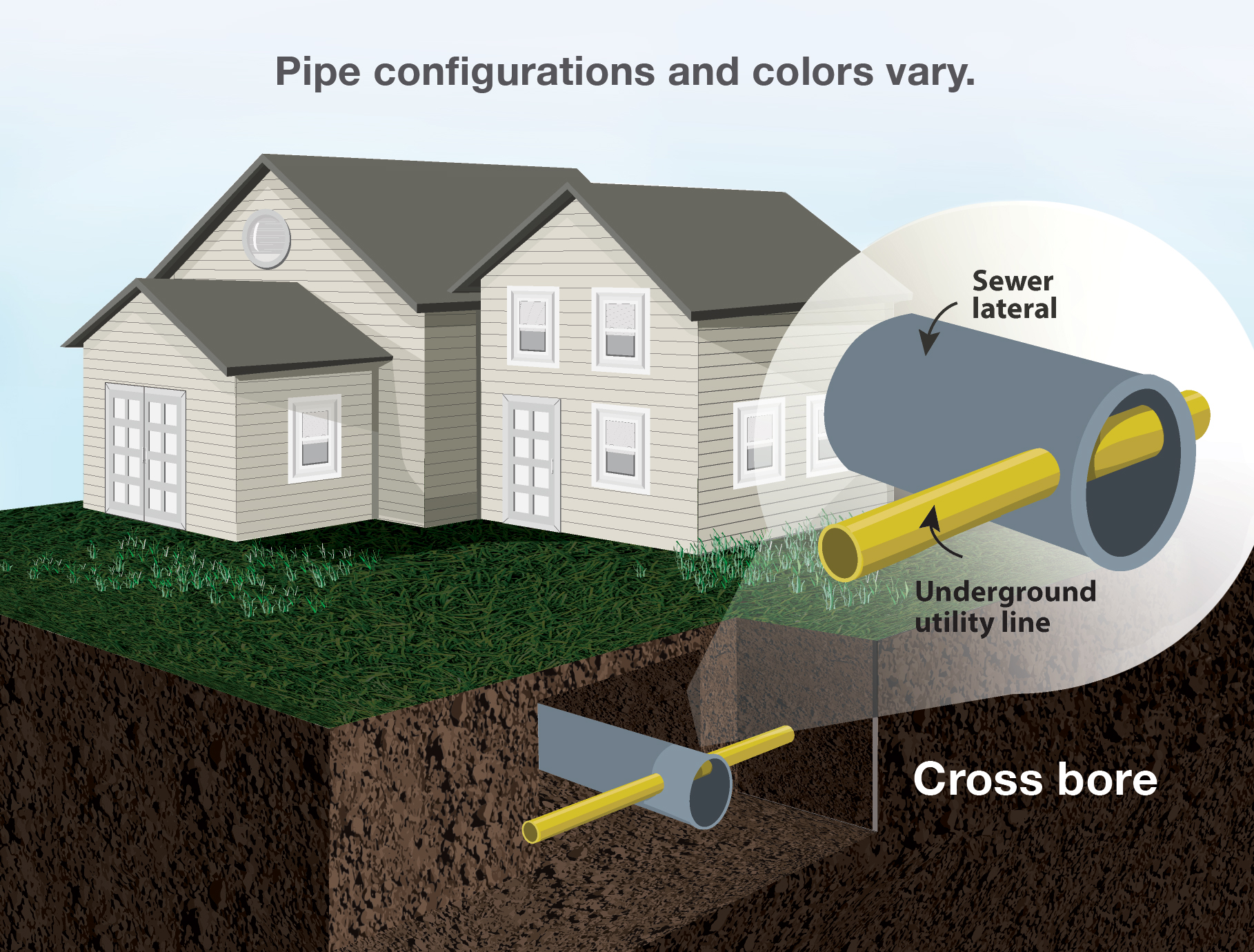| View in browser > |
 |
| Understanding cross-bore emergencies |
|
An underground utility line that has been inadvertently installed directly through a sewer pipe is known as a “cross bore.” A cross bore can go unnoticed for years until the utility line obstructs the flow of waste in a sewer lateral, leading to a blockage or backup. Removing this blockage with mechanical clearing equipment can damage the cross-bored utility line, resulting in personal injury and property damage. Use the tips below to respond to emergencies involving cross-bored natural gas and electric lines. |
|
|
 |
 |
The risks of cross-bore damage
If clearing equipment cuts into a cross-bored natural gas pipe, leaking gas can enter the sewer system, travel into multiple structures and reach explosive concentrations in a matter of moments. A small spark from any source could ignite the gas, destroying buildings and resulting in catastrophic loss of life. Electrical cross bores pose risks as well: a plumber or drain cleaner who contacts a cross-bored electric line with clearing equipment may suffer a serious electrical shock. |
|
Damage to cross-bored natural gas or electric lines can also interrupt critical utility services. |
Dispatch response
Dispatchers: Upon receiving the report of a cross-bore incident, initiate a full public safety response appropriate to the reported hazard. If the situation involves a natural gas cross bore, inform the incident commander that natural gas may be entering the sewer system. Once first responders have been toned, notify National Grid of any reported cross-bore incident and specify the involved utility system (electric or gas). |
| If a caller reports bubbles and/or a strong natural gas odor rising from the entry point of the clearing equipment (usually a sink, toilet or drain), assume a cross-bored natural gas line has been cut and instruct the caller to take these steps: |
|
| • |
 |
Do NOT start or turn off sewer line‑clearing equipment. |
|
| • |
 |
Evacuate the premises and take everyone with you. Leave all equipment behind and leave the exit door open. |
|
| • |
 |
Do NOT attempt to stop the flow of gas. |
|
| • |
 |
Do NOT use matches, lighters, cigarettes, e‑cigarettes, vape pens, light switches or anything electrical – not even a phone or garage door opener. A spark from any of these items could ignite leaking gas and cause an explosion. |
|
| • |
 |
If a manhole cover has been removed, do not attempt to replace it. |
|
| • |
 |
Meet the responding fire officer at least 100 feet away and upwind from the structure. |
|
| |
|
|
If the equipment operator has suffered an electrical shock and is still in contact with energized clearing equipment, advise the caller to stay away from the victim and the equipment and await the arrival of National Grid and emergency medical personnel. A victim who is no longer in contact with the equipment should be moved to a safe area to receive first aid, including CPR if needed. Instruct the caller to make sure that electrical shock victims receive medical help as soon as possible, whether or not injuries are immediately apparent. |
|
|
Firefighter response for a damaged natural gas cross bore
Firefighters called to the scene of a suspected gas leak from a damaged cross-bored gas line should take these steps: |
| 1. |
 |
Approach the incident scene cautiously. Park at least 100 feet from the building, upwind and away from manhole covers and storm sewer grates. |
|
| 2. |
 |
Recognize the potential for gas to rapidly migrate through the sewer system, accumulate in other structures and expand the scope of the incident. |
|
| 3. |
 |
Request the response of sewer department personnel and a map of the sewer system. |
|
| 4. |
 |
Establish a unified command. |
|
| 5. |
 |
Do NOT open or close underground gas valves in the street at any time. Only National Grid personnel should operate these valves. |
|
| 6. |
 |
Evacuate the building of all occupants and bystanders in the hot zone. Evacuate surrounding warm zone structures as well. Consult the DOT Emergency Response Guide 115 for specific evacuation guidance. The National Grid emergency representative can provide additional evacuation recommendations. |
|
| 7. |
 |
If you have been trained to do so, use a properly calibrated combustible gas indicator (CGI) to assess the hazard level around nearby manholes, vaults and sewer drains. |
|
| 8. |
 |
Do NOT pull manhole covers to vent gas from sewer systems, as friction on the metal cover could cause a spark that ignites the gas. Work with National Grid to develop a plan for venting manholes in the vicinity of the leak. |
|
| 9. |
 |
Never ventilate a building without first coordinating with National Grid and verifying gas has been shut off and ignition sources have been eliminated. |
|
| 10. |
 |
Do NOT enter structures unless operations are coordinated with the National Grid emergency representative and approved by your incident commander. |
|
| 11. |
 |
If you are assigned to enter a structure, do so only with full personal protective equipment (PPE), including self-contained breathing apparatus (SCBA), and take these precautions:
|
|
| • |
 |
Eliminate open flames, cigarettes (including e‑cigs or vape pens) and spark-producing equipment in the vicinity of the leak. |
|
| • |
 |
Use intrinsically safe radios and flashlights. Do not ring doorbells or turn on or off any electrical switches, as a spark from these devices could ignite the gas. Do not step on doormats; friction from your boots could create a spark of static electricity. |
|
| • |
 |
Ventilate from the top down and consider wind direction. In most situations, natural air currents will allow the gas to diminish and power ventilation is not necessary. |
|
| • |
 |
If power ventilation is necessary to clear the structure, use intrinsically safe ventilators and positive pressure ventilation on the upwind side. Take care not to exhaust gas into adjacent structures. |
|
|
 |
⚬ |
 |
Remember: If a high concentration of gas is present, it may fall into the explosive range as a structure is ventilated. |
|
| 12. |
 |
Have a charged hand line with a fog nozzle ready to use in the event of a fire. The general rule is to never put out a gas-fueled fire, but you may use a fog spray to cool combustible exposures and assist with rescue operations. |
|
|
|
 |
| Anyone who suspects a natural gas pipe is obstructing a sewer line should call National Grid at 1‑877‑370‑5047. If a gas pipe has caused the blockage, National Grid will remove the pipe and make repairs at no charge. |
|
|
|
| Keep yourself, your team and the public safe this fall and year‑round. Visit firstresponder.ngridsafety.com today to register and complete your utility safety training. |
|
|
|
| |
| |
|
| To report emergencies, call 911 and National Grid immediately. |
| |
 |
| In case of gas emergencies: |
 |
Long Island and the Rockaways:
911 and 1‑800‑490‑0045 |
 |
Metro New York:
911 and 1‑718‑643‑4050 |
 |
Upstate New York:
911 and 1‑800‑892‑2345 |
 |
Massachusetts:
911 and 1‑800‑233‑5325 |
 |
| |
|
|
|
|
| |
|
|
|
| |
| |
|
 |
#14235 © 2023 Culver Media, LLC |
|
| |
|
|
|
 |
|
|